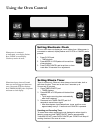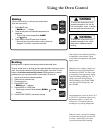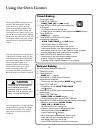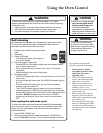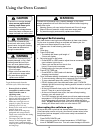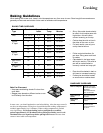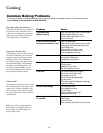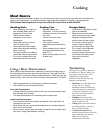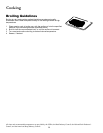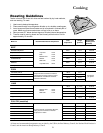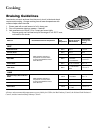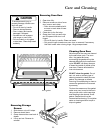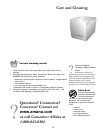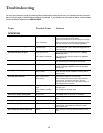19
Cooking (cont'd)
Meat Basics
While cooking has always been a talent, it is now becoming a science, also. Amana provides this information as a
guide to aid in preparation. For specific questions regarding meat preparation, handling, or storage contact
USDA (United States Department of Agriculture) Meat & Poultry Hotline at (800) 535-4555.
Handling Hints
When shopping, put meat in its
own separate plastic sack to
keep drips off other foods.
Defrost frozen meats in
refrigerator, not at room
temperature.
Keep meat cool and covered
until it is time to cook.
Wash hands with warm soapy
water before and after handling
meat or raw egg.
Thoroughly wash any surface or
utensil raw meat or egg touched.
Do not put cooked meat on the
same plate that held raw meat.
Cooking Tips
Marinate meat in the
refrigerator. Throw out excess
marinade that came into contact
with meat.
Use an oven-proof meat
thermometer.
Cook meat to internal
temperature recommended by
USDA.
When reheating foods, heat to
an internal temperature of at
least 165 °F.
While cooking meats, turn over
at least once.
Storage Safety
Once carved, refrigerate unused
portion immediately.
Keep hot foods hot and cold
foods cold when serving meals.
Separate cooked foods into
small portions for fast cooling.
Do not store cooked ground
meats or meals containing
ground meats for longer than
3 to 4 days in the refrigerator.
Do not allow cooked or
uncooked meat juices to come
into contact with ready-to-eat
foods such as fruits or
vegetables.
Using a Meat Thermometer
When using a meat thermometer, remember to insert it at a slight angle, in
the thickest part of the meat, away from fat and bone. The meat should be
removed when 5°F below the desired final temperature. While the meat sits
before carving, it will continue to cook internally, raising the last 5°F by itself.
A meat thermometer can
Take the guesswork out of cooking to a desired doneness.
Help reduce the risk of foodborne illness.
Oven-safe Thermometer
Inserted before the meat is placed in the oven, this thermometer stays
with the meat while it cooks.
The internal temperature will rise slowly as the meat cooks.
Instant-read Thermometer
Not oven safe, these thermometers are placed in the meat when it is
removed from the oven.
While times may vary, an accurate temperature is normally displayed
within one to two minutes.
When using an instant-read, remember to clean the thermometer stem
with warm, soapy water between readings.
Tenderizing
Braising is only one way to tenderize
less tender cuts. Before cooking, you
may pound, cube, marinate, or use
commercially prepared meat
tenderizers. You may then use a dry
method to cook the meat.
Marinades are acidic liquids such
as wine, citrus, or vinegar.
Marinades soften meat fibers but
only penetrate about one-fourth of
an inch into the interior of the
meat. Do not marinate meat for
longer than 24 hours.
• Pounding with a heavy meat
mallet breaks down the connective
tissue to tenderize meat.
• Cubing breaks down the structure
more than pounding. Cubing is
done at the meat counter.
• Commercial tenderizers are
primarily enzymes that work on the
outer fourth inch on a meat cut.
Make sure to follow the
manufacturer’s directions.




